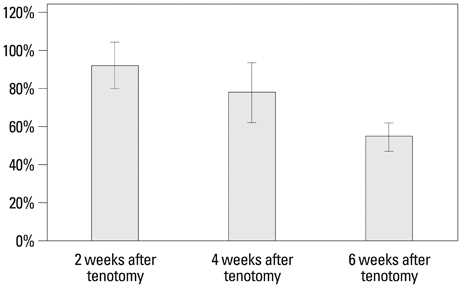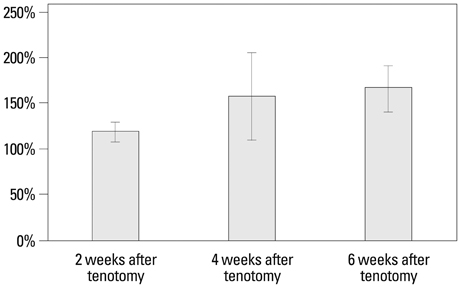Yonsei Med J.
2014 Sep;55(5):1395-1399. 10.3349/ymj.2014.55.5.1395.
Passive Skeletal Muscle Excursion after Tendon Rupture Correlates with Increased Collagen Content in Muscle
- Affiliations
-
- 1Department of Orthopaedic Surgery, Yonsei University College of Medicine, Seoul, Korea. yrchoi@yuhs.ac
- KMID: 1799508
- DOI: http://doi.org/10.3349/ymj.2014.55.5.1395
Abstract
- PURPOSE
This study was designed to measure time-dependent changes in muscle excursion and collagen content after tenotomy, and to analyze the correlation between muscle excursion and collagen content in a rabbit model.
MATERIALS AND METHODS
Twenty-four rabbits underwent tenotomy of the second extensor digitorum longus (EDL) muscles on the right legs and were randomly assigned to three groups based on the period of time after tenotomy (2, 4, and 6 weeks). The second EDL muscles on left legs were used as controls. At each time after tenotomy, passive muscle excursion and collagen content, determined by hydroxyproline content, were measured bilaterally, and the ratio of each value to the normal one was used.
RESULTS
The mean ratio of muscle excursion after tenotomy to the value of the control decreased in a time-dependent fashion: 92.5% at 2 weeks, 78.6% at 4 weeks, and 55.1% at 6 weeks. The mean ratio of hydroxyproline content in muscle to the value of the control increased in a time-dependent fashion: 119.5% at 2 weeks, 157.3% at 4 weeks, and 166.6% at 6 weeks. There was a significant negative correlation between the ratio of hydroxyproline content in muscle after tenotomy to the control values and the ratio of muscle excursion after tenotomy to the control values (r=-0.602, p=0.002).
CONCLUSION
The decrease in muscle excursion seems to correlate with the increase in collagen content in the muscle in a time-dependent fashion following tenotomy.
Keyword
MeSH Terms
Figure
Reference
-
1. Jamali AA, Afshar P, Abrams RA, Lieber RL. Skeletal muscle response to tenotomy. Muscle Nerve. 2000; 23:851–862.
Article2. Józsa L, Kannus P, Thöring J, Reffy A, Järvinen M, Kvist M. The effect of tenotomy and immobilisation on intramuscular connective tissue. A morphometric and microscopic study in rat calf muscles. J Bone Joint Surg Br. 1990; 72:293–297.3. Baker JH, Hall-Craggs EC. Changes in sarcomere length following tenotomy in the rat. Muscle Nerve. 1980; 3:413–416.
Article4. Tsai AM, Jamali AA, Abrams RA, Lieber RL. Skeletal muscle recovery following tenotomy and simulated seven day delayed tendon repair. Trans Orthop Res Soc. 1998; 23:663.5. Jeon SH, Chung MS, Baek GH, Lee YH, Gong HS. The effect of muscle excursion on muscle recovery after tendon repair in a neglected tendon injury: a study in rabbit soleus muscles. J Orthop Res. 2011; 29:74–78.
Article6. Lieber RL, Fridén J. Functional and clinical significance of skeletal muscle architecture. Muscle Nerve. 2000; 23:1647–1666.
Article7. Takahashi M, Ward SR, Marchuk LL, Frank CB, Lieber RL. Asynchronous muscle and tendon adaptation after surgical tensioning procedures. J Bone Joint Surg Am. 2010; 92:664–674.
Article8. Józsa L, Bálint BJ, Vándor E, Réffy A, Demel Z. Recapillarization of tenotomized skeletal muscles after delayed tendon suture I Experimental study. Res Exp Med (Berl). 1985; 185:163–168.
Article9. Böl M, Leichsenring K, Weichert C, Sturmat M, Schenk P, Blickhan R, et al. Three-dimensional surface geometries of the rabbit soleus muscle during contraction: input for biomechanical modelling and its validation. Biomech Model Mechanobiol. 2013; 12:1205–1220.
Article10. Lieber RL. Skeletal muscle adaptability. I: Review of basic properties. Dev Med Child Neurol. 1986; 28:390–397.
Article
- Full Text Links
- Actions
-
Cited
- CITED
-
- Close
- Share
- Similar articles
-
- In-vivo Study of the Effects of Tenotomy on Biomechanical Properties of Triceps Surae in Rabbit
- Repair of Neglected Rupture of the Achilles Tendon using V-Y Tendinous Flap
- The Effect of Muscle Length and Excursion on Myostatic Contracture : A Study in Rabbit Soleus Muscles
- Glycogen Contents in Skeletal Muscles in Men and Different Species of Experimental Animals
- Chronic Tibialis Anterior Tendon Rupture Treated with Semitendinosus Autograft: A Report of Two Cases



